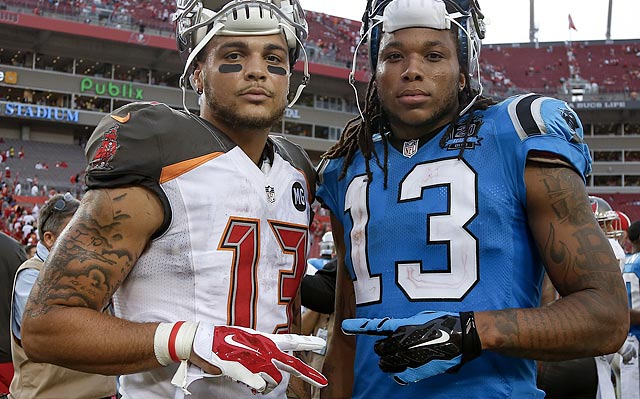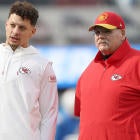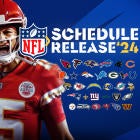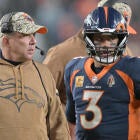TAMPA, Fla. -- Mike Evans was part of arguably the best rookie class of receivers the NFL has ever seen.
Like many in the 2014 class, Evans put up impressive numbers, catching 68 passes for 1,051 yards and 12 touchdowns for the Tampa Bay Buccaneers last season. He was one of three rookie pass catchers to go over 1,000 yards, the first time that happened in league history.
That group -- which included Carolina's Kelvin Benjamin and Odell Beckham Jr. of the New York Giants (Buffalo's Sammy Watkins had 982) -- burst onto the scene and finished with big numbers at a position that has seen rookies traditionally struggle.
It almost looked easy.
"Oh, it wasn't as easy as it might have looked," Evans said following the team's second minicamp practice here. "By the third or fourth week, I was more comfortable, and that's when it took off for me."
In the locker next to Evans, 11-year veteran receiver Vincent Jackson -- a pseudo big brother and mentor -- dresses. When Jackson came into the league in 2005 with the San Diego Chargers, he caught three passes for 59 yards as a backup used mainly on special teams. There was none of this I-am-here-give-me-the-ball treatment back then for him.
"We waited and learned," Jackson said.
In fact, it was rare for most receivers to make huge impacts in their first season. Look up the rookie years of some of the league's best from the past decade, and you will be shocked at the numbers. Calvin Johnson didn't come close to 1,000 yards on his 48 catches as a rookie. Arizona's Larry Fitzgerald had 58 catches for 780 yards. Atlanta's Roddy White, who was in the same draft class as Jackson, had 29 catches for 446 yards as a rookie.
Take it even a step further back. Guys like Terrell Owens, Marvin Harrison and Steve Smith -- all ranked in the top 20 in career receptions -- didn't have huge rookie seasons. Randy Moss is one of the few who dominated as a rookie.
So what changed? How can these receivers come in now and do so much as rookies?
"It could be partially explained by colleges running spread offenses and by NFL changing rules, making it easier to pass," one general manager said. "Also, I think teams in college are taking their best athletes and making them receivers."
The emergence of more spread offenses in football, with more option routes outside, has helped the younger receivers. In the past, rookie receivers would show up and their heads would be spinning trying to decipher all the coverages they saw, as well as working on the little things it takes to play receiver in the NFL.
They were thinking. Not running.
There are still many more complicated looks in the NFL, but the receivers now are much more used to what they are asked to do when they reach the league.
"The college game is developed more," Jackson said. "And these guys all got put right in there. I was in a situation when I came in where we didn't need to do that. I was able to pick things up slowly. I appreciate that I got to do it that way."

But we live in a society now where everything is now and faster than now. Patience is no more.
A player gets drafted, and with the pressure to win on coaches and general managers, they are often put onto the field as a starter right away, especially first-round guys. Coaches can't wait. General managers can't wait. Million-dollar jobs are on the line.
"It's not like it used to be when you could wait behind veterans," Jackson said. "I got to watch and learn from guys like Keenan McCardell and Eric Parker. There wasn't as much pressure right away."
In addition to the spread systems in college ball, Jackson brought up another good reason why the rookies now are more advanced: seven-on-seven tournaments.
There is a cottage industry in these seven-on-seven tournaments, summer happenings all over the country, with high school kids getting to showcase their talents -- sometimes on television. They offer many more chances for receivers to run more routes in a competitive environment that other generations didn't get the chance to do.
"Those kinds of things weren't available 10 to 15 years ago," Jackson said. "I'd go play baseball, soccer, basketball and track in the spring. These kids now hone in on one sport. They play football year-round."
Evans, who didn't play football until his senior year in high school, offered another reason why the young receivers are more prepared: the Internet.
"You have way more access to watching people play," he said. "You can study guys. I learned a lot on there. I watch receiver drills. I go on YouTube and search Randy Moss, and his one-on-one drills will be on there. You can watch any of the guys and learn a lot."
Some coaches I asked about the rookie receivers said they still have a huge jump from what they learned in college to what they need to do in the NFL, despite the success at last year's class. Evans mentioned the challenge of running more option routes based on coverage. That takes work and repetition.
The real reason for the success might simply be a lot easier than any of this, summed up best by Evans.
"There was an amazing amount of talent in our class," he said.
So much so that it's now considered the best rookie receiving class ever -- one that will be tough to top.





















